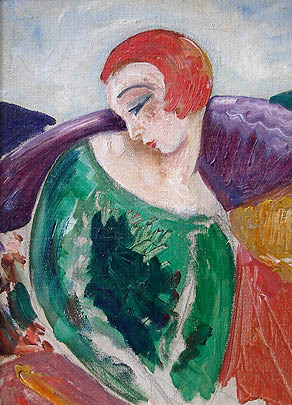

EINAR WEGENER
"PORTRAIT DE FEMME"
OIL ON PANEL, SIGNED
DENMARK, DATED 1923
14.5 X 10.5 INCHES
From Copenhagen to Paris, Gerda Wegener's paintings of beautiful women caused a sensation, not least because of her mysterious model - who was in fact Gerda's husband, Einar. Their unusual story began in 1902 when 17-year-old Gerda left her native Jutland and moved to Copenhagen. The daughter of a minister, Gerda came to Copenhagen to become an artist. Two years after arriving, she met Einar Wegener at the Academy of Art, and they were soon married; Gerda was 19 and Einar 22. They were both artists, and though it was often said that Einar was the better of the two, it was Gerda who made more of a name for herself. In 1904 she showed paintings in Charlottenborg Art Gallery and also won an illustration prize from Politiken newspaper. This notoriety propelled her into the world of fashion magazines, where she became one of the leading illustrators of the Art Deco movement. Over time Gerda became famous for her paintings of beautiful women with haunting almond-shaped eyes dressed in chic fashions. However, around 1913 it was discovered that Gerda's women were in fact men, or at least one man - Einar himself. No one had suspected before then that the petite femmes fatales of Gerda's work could have been modeled on anyone other than a woman, but Einar had acted as Gerda's chief model for years. In provincial-minded Copenhagen the scandal was enough to drive the couple to Paris - a city whose avant-garde tastes catered more to their lifestyle. After the couple arrived in Paris, those who got to know them were soon introduced to the mysterious Lili Elbe - Einar's alter ego. Though somewhat shy at first, over the 19 years Gerda and Einar were married, Lili appeared more and more. Coquettish and playful in the same way that Gerda's painted women were, Lili slowly usurped Einar in body and mind. By the mid-1920s she was making nightly appearances in clubs all over Paris, as well as in Gerda's pictures. For her part, Gerda seemed to have no problem with Lili. Gerda lived openly as a lesbian, so alternative sexual orientations were something she understood well. The married couple - now effectively a trio - lived together quite comfortably. According to Nikolaj Pors, an expert on the couple, "They were both the parents of Lili. They both wanted her around. Some nights when things were a little boring, Gerda would say, 'Let Lili come over tonight', and Einar would hop into women's clothes." However, some have a less idealistic view of the couple's relationship, especially of Gerda's influence over her husband. In fact Gerda has even been called a 'murderer' for encouraging Einar to have a sex change operation in 1929. Einar was the first person ever to have this operation. After it was over, Lili was a reality; however, another reality was the end of the couple's marriage. The unprecedented change of sex threw a monkey wrench into the Danish marriage registry. Because Gerda and Lili were now both women, they could not be married under Danish law. After 19 years the Wegener's marriage was annulled, and the couple went their separate ways. Gerda married an Italian diplomat and moved to Morocco, and Lili began pursuing an affair with her doctor. Lili also had two more operations and by 1931 she felt complete, but for one detail: she felt that it was necessary that she have ovaries to be a real woman. Traveling to Stockholm, she underwent her fourth operation; however, the procedure proved to be deadly, and she died only a few days afterwards. When the news reached her, Gerda was devastated. Almost overnight she divorced her husband and returned to Copenhagen, where she locked herself into a small rented flat. The story of the Wegeners has been made into a documentary film by Nordic Films, and formed the basis of a recent novel, The Danish Girl, by American writer David Ebershoff. |